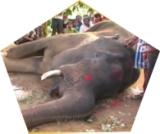Archives
Inferno
The places that experienced maximum heat are Bolangir’s Titlagarh and most other parts, Jharsuguda, Angul and parts of western Odisha. The mercury has shot beyond 46 degrees Celsius in Titlagarh making it the hottest place in the state. Even life in the capital city of Bhubaneswar is badly hit because of the summer heat and humidity. Mid-days have become the no commuting time for the city dwellers. What bothers people is that if the situation is so harsh in the middle of April, what will the situation be like in the month of June till monsoon comes? To add to the worries, there has been no indication of a timely monsoon even though a few experts expected the monsoon to visit the peninsular coasts of India in the first week of June.
| The forests of Odisha that are already in danger due to deforestation and development work are now experiencing the wrath of heat, fire and increasing |
In order to avoid more casualties to the heat of summer, the government has issued special directions to the administration at the district level and has also advised people not to venture out in the daytime without sufficient precautions, as the Revenue and Disaster Mitigation Minister confirmed. “The government is also facilitating supply of drinking water in places with acute water scarcity,” said the Chief Secretary of Odisha Bijay Kumar Patnaik when asked about the heat wave across the state.
Odisha has been experiencing extreme heat during the summer over the last decade. Every year, hundreds of people are falling victim to sunstroke and heat wave. The concerned government departments came up with measures like distribution of water in public places and with advice for people about what ‘to do’ and ‘not to do’ to escape the wrath of summer. However, the issue needs an approach for a long term solution for which locating the reasons should be the priority.
Cities turn concrete jungles
| “District administrations of concerned districts are asked to give reports so that we can get confirmation about other cases” |
Development, rapid industrialisation and housing needs matching the population growth have only helped cities and industrial centres of the state to become concrete jungles besides the thinning of the green cover. With the boom in the real estate business in almost all cities and industrial complexes, both the green cover and water bodies started disappearing in the name of housing and development. Water bodies are being filled up by the builders and ponds are metamorphosing into housing complexes and vertically shot up apartment buildings. That’s why, “Dotted more closely once upon a time, almost all the water bodies in the filigree city of Cuttack are filled up by people and real estate dealers to raise simplex, duplex and apartments. Once known to be a swampy city with ample free space, Cuttack has now become a dense concrete jungle,” said Subhransu Mohanty – a TV Producer and communication consultant from the city of Cuttack.
 The situation is the same in Bhubaneswar. Even though the city has a lower number of water bodies compared to Cuttack, most of them are now a part of history as all have been grabbed by land mafias in connivance with revenue officials. Now big apartments and housing projects are raised on many ponds and low lying areas which were known to be water logging areas. The situation in the outskirts is even more concerning as both agricultural fields and water bodies are disappearing faster to provide the city with required space for its expansion. People of outskirt villages are also into filling up of village ponds and developing these into housing land for this practice fetches huge amounts of money. “The ponds or water bodies which were individual or private properties have faced such a fate, not those which are recorded by revenue department. And, you can’t tell someone to stop doing this because he needs the money and the pond is valueless unless it is filled and converted into housing land. People in outskirt villages are lured by the money they are offered for land. So, why would they think of conserving a pond that is useless for them? It depends on our civic responsibility. But, again, you can’t impose this on poor villagers and people who are in need of money for their development,” said a leading infrastructure leasing and development consultant of Bhubaneswar Tarun Barik.
The situation is the same in Bhubaneswar. Even though the city has a lower number of water bodies compared to Cuttack, most of them are now a part of history as all have been grabbed by land mafias in connivance with revenue officials. Now big apartments and housing projects are raised on many ponds and low lying areas which were known to be water logging areas. The situation in the outskirts is even more concerning as both agricultural fields and water bodies are disappearing faster to provide the city with required space for its expansion. People of outskirt villages are also into filling up of village ponds and developing these into housing land for this practice fetches huge amounts of money. “The ponds or water bodies which were individual or private properties have faced such a fate, not those which are recorded by revenue department. And, you can’t tell someone to stop doing this because he needs the money and the pond is valueless unless it is filled and converted into housing land. People in outskirt villages are lured by the money they are offered for land. So, why would they think of conserving a pond that is useless for them? It depends on our civic responsibility. But, again, you can’t impose this on poor villagers and people who are in need of money for their development,” said a leading infrastructure leasing and development consultant of Bhubaneswar Tarun Barik.
Even though there is a law to restrict conversion of agricultural land and water bodies into land for housing, laws are openly flouted by moneyed people and real estate dealers and the business goes on. Nobody including the government housing agencies bother about the far reaching impact of such a practice in the name of housing and development. Many of the government housing projects are also raised on low land areas that were carrying water for a long time.
 Even though every summer is becoming harsher than the previous, hundreds of trees have been felled by the government itself in the name of beautification and widening of the roads in the capital city. Instead of planting saplings before cutting the trees, the government has just been irresponsive to the law and cut down the trees for its road related work. The city rather looks for greenery in the decorative grass and cactus on the roadside. It seems the havoc of heat in the capital city of Bhubaneswar is a creation of the government itself.
Even though every summer is becoming harsher than the previous, hundreds of trees have been felled by the government itself in the name of beautification and widening of the roads in the capital city. Instead of planting saplings before cutting the trees, the government has just been irresponsive to the law and cut down the trees for its road related work. The city rather looks for greenery in the decorative grass and cactus on the roadside. It seems the havoc of heat in the capital city of Bhubaneswar is a creation of the government itself.
“Yes, development is required. We need our cities to be beautiful and the roads to be widened. We can’t stop that. But, we can’t also ruin the environment and let the cities burn like this every summer. It’s not only the government, but people who should also contribute to the conservation of the environment. If deforestation is required in the city for development work, we must create forests and required water bodies in the outskirts,” says Tarun Barik.
Forest and wildlife at risk
Even as the cities and the human habitations are reeling under the heat wave, the situation in the forests is no better.
 The forests of Odisha that are already in danger due to deforestation and development work are now experiencing the wrath of heat, fire and increasing temperature. The heat of the scorching sun added with ground fire in different forests have made the forests unfit for wildlife because the water sources have gone dry. This is the reason why wildlife is more often than not found venturing into human habitations for food and water.
The forests of Odisha that are already in danger due to deforestation and development work are now experiencing the wrath of heat, fire and increasing temperature. The heat of the scorching sun added with ground fire in different forests have made the forests unfit for wildlife because the water sources have gone dry. This is the reason why wildlife is more often than not found venturing into human habitations for food and water.
On the 8th of May 2012, an elephant calf fell in a dried up well while in search of water in Bolangir’s Agalpur. The calf was rescued through the combined efforts of the villagers and forest department people. At least two elephants have died of heatstroke in Denkanal district in the last month. It seems that the increasing temperature and water scarcity in the forests have put the wildlife at a greater risk.
However, the Forest Department is taking remedial steps, says P. N. Padhi, the Principal Chief Conservator of Forest (PCCF) of Odisha who mentioned that, “Water scarcity is there, it’s a fact. The wildlife sometimes also faces water stress. In that situation, we have put emphasis on the creation of water bodies. Last year we have already created 800 water bodies and this year we have a programme to create around 1000 water bodies.”
The cases of forest fires have also increased this year. Because of a dry spell that continued for a longer period this year, the cases of forest fires have gone up to more than 2700 this year against about 700 last year, confirms the PCCF. This has not only increased the temperature in the forests but also put the whole green belt at further risk.
Looking at the increasing cases of forest fires, the Forest Department is trying to control this by involving the communities living in the forest villages and by taking up other measures that will at least stop fire from spreading. “To control the fire, the department has facilitated the involvement of village communities and Van Suraksha Samitis (VSS), involvement of fire fighting squads and arranging their mobility and construction of watchtowers. We have also developed a system of constructing fire lines. Every division is constructing around 100-500 km of fire lines depending on the fire incidents and magnitude of the division,” says Padhi who believes that such fire lines which are 10-20 meter wide cleaned strips running in the forests, will stop fires from spreading.
When both humans and wildlife are reeling under the heat wave in the state, the issue requires serious attention and a long term solution. A balance between concretization in the name of development and environment conservation has to be worked out and steps must be taken immediately otherwise, the issue will become more critical in the coming years and summer will become the season of deaths and disasters in the state of Odisha.

